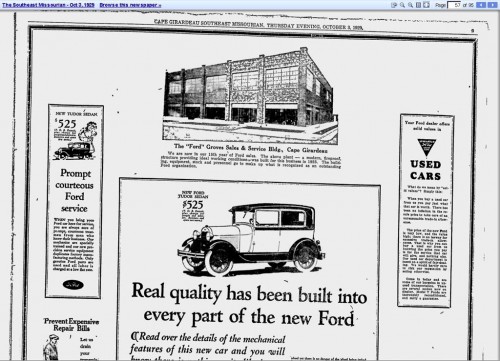 The first gas-powered automobile of record in Cape Girardeau was a Great Northern owned by George McBride, a stave manufacturer. The year was 1904. The Missourian’s 25th Anniversary edition has a fascinating history of the automobile from a 1929 perspective.
The first gas-powered automobile of record in Cape Girardeau was a Great Northern owned by George McBride, a stave manufacturer. The year was 1904. The Missourian’s 25th Anniversary edition has a fascinating history of the automobile from a 1929 perspective.
Other motorists in 1904
Dr. A.D. Blomeyer drove a Locomobile, a slow-moving, steam-powered vehicle.
The first gasoline bus was the “Red Devil,” bought by William Gockel. The paper said that “the Red Devil remained true to its name during the period Mr. Gockel was its owner and he finally gave it away for fear it may take a notion to return to the place from which, as its name indicated, it originally came.”
Buggy manufacturer considers Cape
Not everyone was so sure automobiles were going to be a permanent transportation fixture. Russell Gardner, a prominent St. Louis buggy manufacturer, came to Cape in October, 1904, to select a location for a buggy factory that was to be in operation by March of the next year. The factory was never built.
Cape automotive pioneers
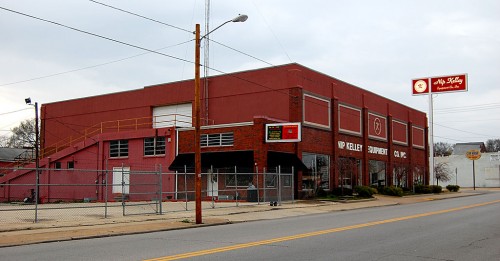
Fred A. Groves and O.G. Edwards came to Cape in 1914 to start an automobile business. They had been in business together in Farmington, a Missourian story explained, when they decided to give Cape a go.
It took them three days to drive from Farmington to Cape Girardeau. One day from Farmington to Ste. Genevieve; one from Ste. Gen to Perryville, and one to cover the 35 miles from Perryville to Cape.
The two young men established an agency for Hudson and Hupmobile. Edwards went back to Farmington, but Groves stayed in Cape. He took over the Ford agency in 1914. Groves sold 5,526 Ford Model Ts and 500 Model As in his first 15 years.
Other early Cape car dealers
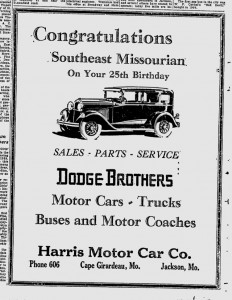 A Dodge franchise went to Thomas L. Harris.
A Dodge franchise went to Thomas L. Harris.- Rudert and Sons started in the garage and automobile agency business in 1917.
- Albert P. Rueseler and Walter Bohnsack organized the Rueseler-Bohnsack Auto Co. in 1923. The Rueseler Motor Co. was formed in 1925, and Bohnsack became a Studebaker dealer.
Significant dates in Cape automotive history
- First car theft: Oct. 21, 1905. Salesman Vince Chapman left his car in front of the Broadway Mercantile Co. “Manufacturers apparently thought there was about as much temptation for the predatory criminal to steal an automobile as to steal a box car or a steamboat and had not provided locks,” The Missourian speculated. There is no indication that the car was recovered. It is estimated that there were perhaps 20 cars in Cape at that time.
- Fastest time Cape to Jackson: July 9, 1906, Joe Wilson drove from Cape to Jackson in a record time of 25 minutes, “probably the shortest time in which the 10 miles had ever been traversed up to that time.”
- First Tin Lizzie: George McBride (remember him) brought the first “Henry” into Cape in May of 1909.
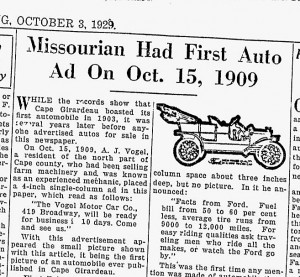 First garage: A.J. Vogel opened the first garage on Jan. 10, 1910. It had a showroom big enough to hold six cars, a washing and cleaning shop and a repair shop. Vogel, a farm machinery salesman and experienced mechanic, placed the first display auto ad to run in The Missourian. The 4-inch, single column ad read: “The Vogel Motor Car Co., 419 Broadway, will be ready for business in 10 days. Come and see us.”
First garage: A.J. Vogel opened the first garage on Jan. 10, 1910. It had a showroom big enough to hold six cars, a washing and cleaning shop and a repair shop. Vogel, a farm machinery salesman and experienced mechanic, placed the first display auto ad to run in The Missourian. The 4-inch, single column ad read: “The Vogel Motor Car Co., 419 Broadway, will be ready for business in 10 days. Come and see us.”- First auto license tax: Dec. 6, 1909. $5.
- First car vs ped: July 21, 1910. Esaw Hendrickson, a Delta farmer, got off a street car between the H&H Building and the Idan-Ha Hotel and stepped in front of a car driven by City Councilman Joe T. Wilson. He was knocked down and run over, but his injuries were not serious.
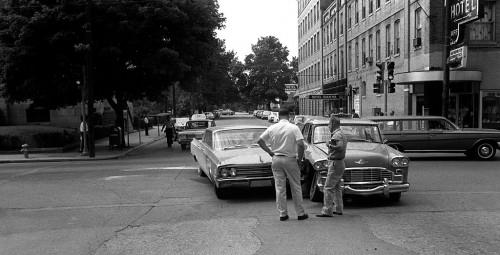 (Cars were still bumping into each other at Broadway and Fountain in 1966. See more photos of this crash, plus read about Fred Kaempher, Cape’s song-writing policeman.)
(Cars were still bumping into each other at Broadway and Fountain in 1966. See more photos of this crash, plus read about Fred Kaempher, Cape’s song-writing policeman.)
- First auto vs bicycle: the day after Mr. Hendrickson’s accident, a car driven by R.B. Oliver, Jr., and a bicycle ridden by Fred Frenzel, a Western Union messenger boy, collided at the corner of Broadway and Spanish. “The boy was not hurt much, but his brand-new wheel was demolished.”
- First funeral procession: Oct. 30, 1916, when the body of Charles E. Booth, a Frisco fireman, was laid to rest. The Brotherhood of Locomotive Firemen and the Odd Fellows asked Booth’s friends to bring automobiles for the funeral procession.
Cars were big business in Cape in ’29
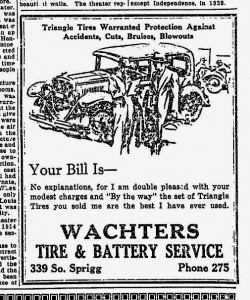 Ten garages were exclusively devoted to repair work; 14 others were dealerships in addition to their garage functions.
Ten garages were exclusively devoted to repair work; 14 others were dealerships in addition to their garage functions.- Two automobile accessory concerns.
- Three automobile battery stations.
- Seven exclusive tire and service stations, not counting garages and stores handling tires.
- One vulcanizing shop.
- At least 30 filling stations.
- Cape automotive landmarks
- First car theft: Oct. 21, 1905. Vince Chapman left the car in front of the Broadway Mercantile Co. “Manufacturers apparently thought there was about as much temptation for the predatory criminal to steal an automobile as to steal a box car or a steamboat and had not provided locks.” There is no indication that the car was recovered. It is estimated that there were perhaps 20 cars in Cape at this time.
- Fastest time Cape to Jackson: July 9, 1906, Joe Wilson drove the 10 miles from Cape to Jackson in a record time of 25 minutes, “probably the shortest time in which had ever been transversed up to that time.”
- First Tin Lizzie: George McBride (remember him) brought the first “Henry” into Cape in May of 1909.
- First garage: A.J. Vogel opened the first garage on Jan. 10, 1910. It had a show room big enough to hold six cars, a washing and cleaning shop and a repair shop.
- First auto license tax: Dec. 6, 1909. $5.
- First Missourian auto ad: Oct. 15, 1909. A.J. Vogel, a farm machinery salesman and experienced mechanic placed a 4-inch single column ad: “The Vogel Motor Car Co., 419 Broadway, will be ready for business in 10 days. Come and see us.”
- First auto crash: July 21, 1910. Esaw Hendrickson, a Delta farmer, got off a street car betwen the H&H Building and the Idan-Ha Hotel and stepped in front of a car driven by City Councilman Joe T. Wilson. He was knocked down and run over, but his injuries were not serious.
- First auto vs bicycle: the day after Mr. Hendrickson’s accident, a car driven by R.B. Oliver, Jr., and a bicycle ridden by Fred Frenzel, a Western Union messenger boy, collided at the corner of Broadway and Spanish. “The boy was not hurt much, but his brand-new wheel was demolished.”
- First funeral procession: Oct. 30, 1916, when the body of Charles E. Booth, a Frisco fireman, was laid to rest. The Brotherhood of Locomotive Firemen and the Odd Fellows asked Booth’s friends to bring automobiles for the funeral procession.

Great seeing the old “Ford Groves” building. This place must have been built like a fort. The cars were soted upstairs, not in the lot like today. Stored indoors so there were always washed and ready to go!
I always wondered why is was Ford Groves and not Grove’s Ford??? Ford Groves house was one of my favorite in Cape.It was located on Cape Rock drive above Dennis Schivlly(sp) Park, nice home with a great setting.
I love cars but never into fixing them, just like to look at them. Which seems to be a theme in life, at my now advanced age.
First time I ever went 100mph was on the back of a Triumph 650, racing a GTO from the stoplight at Broadway and Kingshighway headed south. I think we were in third gear and doing 60 when we passed A&W, we hit the century mark and backed off in time for the Independence light. Mr. Williams in his new GTO was humbled, and I am fortunate to be able to recount this story.
I’m happy that I don’t have any photos of you in handcuffs or with a sheet pulled over you.
I remember when Ford Groves covered their showroom windows announcing the coming of the new 1949 Ford. When the great day came, we couldn’t wait to go down and gawk. And we though it was the greatest thing ever and regreted we were stuck with an old Chevrolet.
Oh well, now that we are swapping car stories in “63” or “64”…Remember before I-55 was finished to St. Louis and you had to drive to to Fruitland and then get on…well before the Cape section was opened up. I went 137 mph on that road!
How you might ask, are you sure it was 137 mph and not a little faster or slower…
Well Mr. Westcoat was the Studebaker dealer in town and got in one of the Rare R2 supercharged Avanti’s…Wow this car even today looks fast…He wanted to take if for spin and see how fast it went…We headed north on 61 to the interstate…which was newly opened. It may have been the first day…NO Cars on it at all… We went north for a while checking for cops then turned arouned an heased southbound. Mr. Westcoat fired it up and off we went…I watched the speedo and saw a 140 MPH and he held it there for miles. We exited and drove back to the garage on Broadway. All was well…until about 15 minutes or so. The State Trooper who lived up behind Southeast Hospital, I forgot his name…but he was Capitan in the Mo. Highway Patrol showed up and started to ream Mr. Westcoat and I a new one…It seems one on the Trooper’s in Perryville nailed us at 137 MPH but could not catch us and radioed ahead. Hence the courtesy call from one of Missouri’s finest.
Mr. Westcoat never got the ticket…and I road by Bike back up Perryville road home, at a slower pace. Never told anyone!
I’m surprised that more of my classmates weren’t scooped up with a stick and a spoon.
A friend forwarded an email to me from Sondra Gockel-Hoover, who said William Gockel of Red Devil bus fame was her great grandfather.
“He also delivered mail between St Louis and Cape by horse and buggy prior to that. My grandfather, Gus, drove a greyhound bus between St Louis and Memphis for years and years after that. My great-great uncle, who was a sheriff in Jackson, performed the last hanging performed there… We’ve always been quite a bunch!!”
You can read more about the last hanging and the hanging tree in Jackson here.
This article was so interesting; a lot of very familiar names! Ed Rudert of the Rudert auto people was the instructor of the 3 hour a day auto mechanics class I took in the last two years of high school.
Joe Whitright “45”
Terry —
I believe the State Trooper had to be Glenn Lampley. He was quite a guy.
Yes, Chuck, Glenn Lampley he was. I lived on Sunset Court a block away from him. Not sure he was ever married; the women on my street, Mom included, said he was too “picky” about everything!!??
Glenn “Kraut” Lampley retired as a Lieutenant in Missouri State Highway Patrol in 1970. He also retired as a Colonel in the Missouri Army National Guard. He was one of the first inductees into Central High’s Hall of Fame in July of 1992. He played football for Central in 1925 – 27 and a starter at right Guard for SEMO Indians in 1930.
He and his wife built their home at 1759 Lacey in 1937. Sadly his wife passed away after an extended battle with cancer c. 1957. He and my dad served on the Highway Patrol and in the National Guard together. My dad, Charles Paul Corbin, helped Glenn build his home on Lacy.
In 1966, Glenn did my background investigation to become a Missouri State Trooper. Glenn was a “gentleman who enforced the law” and a role model for my own Highway Patrol and National Guard careers.
Thanks to Ken Steinhoff for yet another highly informative post packed with information.
One question, though: We are informed that Mr. Fred Groves and a partner “came to Cape in 1916 to start an automobile business.” A few lines later we are informed that the partner returned to Farmington, “but Groves stayed in Cape. He took over the Ford agency in 1914.” Which is it, 1914 or 1916? I always heard that Mr. Groves established his Ford dealership in 1914. I believe it’s a fact that the centennial of the business was celebrated in 2014.
1914 is correct, based on several Out of the Past columns I saw. I messed up the link to the story where I got the original dates, so I couldn’t find it quickly.